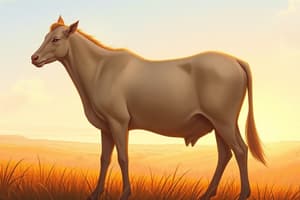Podcast
Questions and Answers
Which type of birth involves embryos developing inside the mother's body?
Which type of birth involves embryos developing inside the mother's body?
- Asexual
- Viviparous (correct)
- Ovoviviparous
- Oviparous
What is a characteristic of ovoviviparous animals?
What is a characteristic of ovoviviparous animals?
- Eggs develop outside the mother and hatch outside
- Embryos develop inside and hatch before or during birth (correct)
- They require parental care for survival
- They reproduce through fission
Which of the following factors does NOT significantly influence gestation duration?
Which of the following factors does NOT significantly influence gestation duration?
- Parental age (correct)
- Environmental conditions
- Species size
- Parental care
Which respiratory mechanism is primarily found in aquatic animals for gas exchange?
Which respiratory mechanism is primarily found in aquatic animals for gas exchange?
What is a significant byproduct of anaerobic respiration?
What is a significant byproduct of anaerobic respiration?
What adaptation increases the efficiency of gas exchange in gills?
What adaptation increases the efficiency of gas exchange in gills?
Which option correctly describes a factor that affects gas exchange rates?
Which option correctly describes a factor that affects gas exchange rates?
What distinguishes assisted birthing methods in some species?
What distinguishes assisted birthing methods in some species?
Flashcards are hidden until you start studying
Study Notes
Birthing in Zoology
-
Types of Birth:
- Viviparous: Live birth; embryos develop inside the mother's body (e.g., mammals).
- Oviparous: Egg-laying; embryos develop outside the mother (e.g., birds, reptiles).
- Ovoviviparous: Eggs develop inside the mother but hatch before or during birth (e.g., some sharks).
-
Gestation:
- Duration varies significantly by species (e.g., elephants: 22 months; mice: 3 weeks).
- Influenced by factors like size, environmental conditions, and parental care.
-
Parental Care:
- Varies among species; includes feeding, protection, and teaching young.
- Essential for survival in many species, especially those with prolonged development.
-
Birthing Methods:
- Assisted vs. Natural: Some species may require assistance during delivery (e.g., livestock).
- Nesting Behavior: Many species exhibit specific behaviors for preparing and protecting young.
Exchange of Gases
-
Respiration Types:
- Aerobic Respiration: Requires oxygen; produces energy efficiently.
- Anaerobic Respiration: Occurs without oxygen; less efficient and produces byproducts like lactic acid.
-
Gas Exchange Mechanisms:
- Gills: Found in aquatic animals; extract oxygen from water.
- Lungs: Found in terrestrial animals; exchange gases with the atmosphere.
- Skin: Some amphibians and invertebrates can exchange gases through their skin.
-
Transport of Gases:
- Oxygen is transported via hemoglobin in blood for most vertebrates.
- Carbon dioxide is expelled from tissues and transported back to respiratory surfaces for release.
-
Factors Affecting Gas Exchange:
- Surface area: Larger areas enhance gas exchange efficiency.
- Concentration gradients: Gases move from areas of higher concentration to lower concentration.
- Environmental conditions: Temperature, pressure, and presence of pollutants can affect gas exchange rates.
-
Adaptations:
- Various adaptations help optimize gas exchange in different environments (e.g., fish gills are highly vascularized).
- Some animals have specialized structures, such as tracheae in insects, to facilitate gas exchange directly with tissues.
Types of Birth
- Viviparous species give live birth with embryos developing inside the mother's body, common in mammals.
- Oviparous species lay eggs, with embryos developing externally, seen in birds and reptiles.
- Ovoviviparous species retain eggs internally with hatching occurring before or during birth, including some shark species.
Gestation
- Gestation periods vary widely; notable examples include elephants with a 22-month gestation and mice at approximately 3 weeks.
- Factors influencing gestation duration include the species' size, environmental conditions, and level of parental care.
Parental Care
- Parental care varies significantly across species, including behaviors like feeding, protecting, and teaching offspring.
- This care is often critical for the young's survival, especially in species with longer developmental stages.
Birthing Methods
- Delivery can be assisted or natural; some animals, like livestock, may require human assistance during birthing.
- Many species exhibit specific nesting behaviors to prepare for and protect their young.
Exchange of Gases
- Aerobic Respiration utilizes oxygen to efficiently produce energy; Anaerobic Respiration occurs without oxygen, yielding less energy and producing byproducts like lactic acid.
Gas Exchange Mechanisms
- Gills are adapted for aquatic animals to extract oxygen from water.
- Lungs serve terrestrial animals, enabling gas exchange with the atmosphere.
- Some amphibians and invertebrates can exchange gases through their skin.
Transport of Gases
- Most vertebrates transport oxygen via hemoglobin in the bloodstream.
- Carbon dioxide is carried from tissues to respiratory surfaces for removal from the body.
Factors Affecting Gas Exchange
- Increased surface area enhances the efficiency of gas exchange.
- Concentration gradients drive gas movement from areas of high concentration to low concentration.
- Environmental factors, like temperature, pressure, and the presence of pollutants, significantly impact gas exchange rates.
Adaptations
- Various organisms have evolved adaptations to optimize gas exchange; for example, fish gills are highly vascularized.
- Insects possess specialized structures, such as tracheae, allowing for direct gas exchange with tissues.
Studying That Suits You
Use AI to generate personalized quizzes and flashcards to suit your learning preferences.




